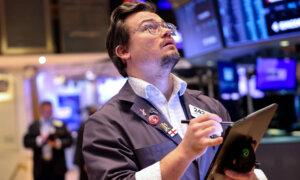‘We will know if we ate all the Christmas cookies before Christmas Eve,’ said Mark Malek, chief investment officer at Siebert Financial.
The Dow Jones Industrial Average is seeking to end its nine-day skid, the longest losing streak in more than 40 years, as investors await a key Federal Reserve policy meeting.
The blue-chip average tumbled 267.58 points, or 0.61 percent, to finish the Dec. 17 trading session at 43,449.90, extending its longest losing streak since 1978.
Investors might be surprised by the sudden turn of events. The broad-based postelection rally since Nov. 5, which had resulted in a string of all-time highs for the leading benchmark indexes, might be fading.
Market watchers attribute the Dow Jones’s decline to investors rotating out of value-focused equities—like energy, financials, and utilities—and into tech.
Still, even with the losing streak, the Dow Jones is resting about 4 percent below its record high.
U.S. stocks could be rebounding ahead of the Dec. 18 opening bell.
The Dow Jones, the tech-heavy Nasdaq Composite Index, and the S&P 500 rose by about 0.3 percent.
Investors are waiting for the Federal Reserve (Fed) to wrap up its two-day Federal Open Market Committee policy meeting, the last of the year.
Markets will focus more on updates to the Summary of Economic Projections, a quarterly survey of Fed officials on the direction of monetary policy in the year ahead.
“Every three months, we get a projection from each Fed official as to where they see rates over the coming years,” Jay Woods, chief global strategist at Freedom Capital Markets, said in a note emailed to The Epoch Times.
“After the September dot plot, we saw the official target for the key benchmark interest rate coming in between 4.25–4.5 percent. That looks like it’s in the cards.”
Inflation could be the wild card for policy heading into 2025.
Since the Fed kicked off the new easing cycle in September with a supersized 50-basis-point interest rate cut, all three inflation reports—the consumer price index, the producer price index, and the Fed-preferred personal consumption expenditure price index—have drifted higher.
Fed Chair Jerome Powell has signaled that he is comfortable with inflation closer to 3 percent than the central bank’s 2 percent target rate. Additionally, with officials lauding the progress on inflation over the past two-plus years, officials have emphasized more on the labor side of their dual mandate.
The Cleveland Fed Inflation Nowcasting model estimates that next month’s annual inflation rate will rise to 2.9 percent, the third straight monthly increase. Core inflation, which strips the volatile energy and food categories, is expected to hold steady at 3.3 percent for the fourth consecutive month.
According to Charu Chanana, chief investment strategist at Saxo Bank, the upswing in inflation data might force officials to trim their rate-cutting forecasts for the upcoming year.
The previous Summary of Economic Projections suggested four rate cuts totaling 100 basis points for 2025. This, says Chanana, could be lowered to “just three or even two cuts as inflation risks remain elevated.”

Traders work on the floor of the New York Stock Exchange as Federal Reserve Chairman Jerome Powell speaks after announcing a rate increase, in New York on Nov. 2, 2022. Seth Wenig/AP Photo
Fewer-than-expected rate cuts would be a “modest negative” for the financial markets, says Tom Essaye, founder and president of Sevens Report Research.
“What would be substantially more negative is if the Fed announces a ‘pause’ and outright stops rate cuts,” Essaye said in a note emailed to The Epoch Times. “There’s no chance the Fed says that tomorrow, but it will be something to watch for in 2025 if inflation and growth data continue to surprise to the upside.”
Powell and his colleagues indicated that near-term decision-making is about balancing the risks. If the Fed cuts too much too early, it could rekindle the inflation flame. If the central bank keeps interest rates too high for too long, it could weigh on economic growth and the labor market.
That said, the economy’s strength has afforded the Fed the luxury of patience and waiting.
“The economy is even stronger than we thought,” Powell said at The New York Times’ DealBook Summit earlier this month. “So the picture is actually stronger than it was.”
Santa Claus Is Coming to Town
Once the market has digested the Fed news, will investors receive a Christmas gift in the form of a Santa Claus rally?
A Santa Claus rally is a market phenomenon in which stocks generally increase during the final week of December and the first two trading days of January.
Odds are pointing to a 72 percent chance of Jolly Old St. Nick stimulating the markets, says Mark Malek, the chief investment officer at Siebert Financial.
In addition to the Fed meeting, investors will comb through the final third-quarter GDP estimate, the University of Michigan’s Consumer Sentiment Index, and inflation.
“Indeed, by the end of this week, we will know if we ate all the Christmas cookies before Christmas Eve,” Malek said in a note emailed to The Epoch Times.
“But don’t lose hope; there is still plenty of time for Santa to get his sleigh to NYC in time for the holiday—just leave a few cookies for him, just in case.”
Original News Source Link – Epoch Times
Running For Office? Conservative Campaign Consulting – Election Day Strategies!


